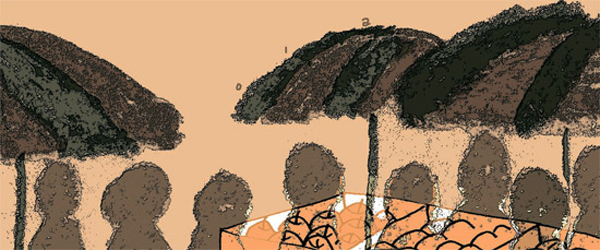The unique charm of village markets

Since early spring, I’ve been touring the five-day markets in Yangpyeong County on my days off. I would pay the weekend off-peak price of 3,100 won ($2.77) from Cheongryangri Station for a 30-minute ride on a Mugunghwa train to Yangpyeong Station. Or I would ride the metropolitan rail for 1,900 won and arrive at Yangsu, Yangpyeong or Yongmun within an hour and a half. The train ride along the Namhan River is very pleasant, and I enjoyed the trees, blooming flowers and green grass of spring. It takes about 45 minutes to drive from Seongsu Bridge to Yangpyeong.
I walked about five minutes from Yangpyeong Station to the market. When I inquired at the Yangpyeong County Office, Kim Seong-ok of the local economy bureau told me that it is a unique market with some 300 street stalls and 30 direct vendors, including farmers doing business within the marketplace. I could find chain bakeries, pizzerias and chicken shops as well as high-end residential towers near the market. There was an interesting contrast between city and country, tradition and modernity.
However, the village market offered unbelievably affordable prices and local tastes. A bowl of red bean porridge and barley rice each cost 3,000 won, buckwheat cake was 2,000 won and sorghum cake was 1,000 won. It felt as if I were in a time machine. I had to wait a long while with my friends for a table, and when we sat down, we ordered everything on the menu to share. The market was crowded with senior citizens, young couples with children, cyclists and youngsters. And I could hear laughter all around.
I had no intention of shopping, but I couldn’t help but buy a block of acorn jelly from an old lady who’s been making the delicacy for 60 years. I also bought 400 grams (14.1 ounces) of soybean paste for 10,000 won, and the vendor generously added three fistfuls. It is the charm of the traditional market that makes customers come back again and again.
April 22 marks one year since the government began controlling supermarket chains to boost local markets. But the Yangpyeong Market proves that traditional markets and supermarkets have different values. Traditional markets have a unique aura that supermarkets will never imitate.
Yangpyeong County was chosen as a “cultural tourism market” by the Small and Medium Business Administration this year. Yangpyeong County Governor Kim Sung-kyo wants to develop the entire county by revitalizing traditional markets. He is also planning to create a new market by integrating cultural elements such as food, art and performance. I can’t wait to see the transformation of the traditional market as it combines history and modernity.
*The author is an editorial writer of the JoongAng Ilbo.
by Chae In-taek
5일장에 가고 싶었다. 수도권 전철을 탔다가 경기도 양평군이 설치한 5일장 안내판을 만난 덕분이었다. 양수장 1·6일, 양평장 3·8일, 용문장 5·10일…. 보는 순간 가슴이 설렜다. 그래서 초봄부터 쉬는 날이면 짬을 내서 양평군의 5일장을 돌아보고 있다. 서울 청량리역에서 주말요금 3100원을 주고 무궁화호 열차를 타면 30분 만에 양평역에 도착한다. 수도권 전철을 타고 1900원의 요금에 1시간 30분 남짓 달리면 중앙선 양수역·양평역·용문역에 다다른다. 도시를 떠나 남한강을 바라보며 기차를 달리는 것도 즐거운데 차창 밖으론 물오른 나뭇가지, 움트는 꽃, 파릇한 풀을 비롯한 봄 정취까지 보너스로 따라왔다. 자동차로는 성수대교 기준 45분쯤 걸린다. 양평 5일장은 양평역에서 걸어서 5분 거리에 있었다. 양평군청에 물어봤더니 지역경제과 김성옥씨가 “이곳은 상설시장 속에 300여 노점상과 30여 직거래 농가 좌판이 모여 5일장이 열리는, 독특한 이중시장”이라고 일러줬다. 시장 주변에는 대도시에서 흔히 보는 체인 빵집·피자집·치킨집이 즐비한 건 물론 주상복합건물까지 우뚝 서있었다. 도시와 농촌, 전통과 현대의 경계라는 묘한 위치였다. 하지만 놀라울 정도로 착한 가격과 흥취는 전통 5일장 분위기 그대로였다. 장마당 좌판 음식 가격은 팥죽 3000원, 보리밥 3000원, 메밀부꾸미 2000원, 수수부꾸미 1000원이었다. 타임머신을 타고 시간을 거스른 듯 했다. 일행과 함께 한참을 기다리다 간신히 자리를 얻어 종류별로 하나씩 나눠먹고 팥죽 한 그릇은 포장으로 들고 나왔다. 끼리끼리 온 어르신, 아이들을 데리고 나들이 나온 젊은 부부, 자전거를 타고 온 사이클족, 삼삼오오 몰려 셀카 찍는 젊은이들까지 시장은 손님들로 미어터졌다. 사방에서 웃음소리가 끊이지 않았다. 구경만 하려고 했으나 60년간 직접 메밀묵·도토리묵을 만들었다는 할머니를 만나선 한 덩이 사지 않을 수 없었다. 400g에 1만원 하는 우렁된장을 샀더니 굳이 세 줌이나 더 담아줬다. 다음에 다시 찾지 않고 배겨낼 자신이 없는 전통장의 흥취다. 22일로 정부가 전통시장 활성화를 위해 대형 마트를 규제한 지 1년이 됐다. 하지만 양평 5일장은 전통시장과 마트는 효용가치가 다르다는 걸 웅변하고 있었다. 그곳에는 마트에선 상상도 할 수 없는 독특한 아우라가 넘쳤다. 양평장은 올해 중소기업청의 ‘문화관광형시장’에 선정돼 한 단계 업그레이드를 시도한다. 김선교 양평군수는 “전통시장 활성화로 양평 전체에 활기를 불어넣을 생각”이라며 음식·미술·공연 등 문화와 결합한 새로운 시장을 구상하고 있었다. 전통과 새로움 사이에서 5일장은 어떤 변신을 할까. 채인택 논설위원










with the Korea JoongAng Daily
To write comments, please log in to one of the accounts.
Standards Board Policy (0/250자)